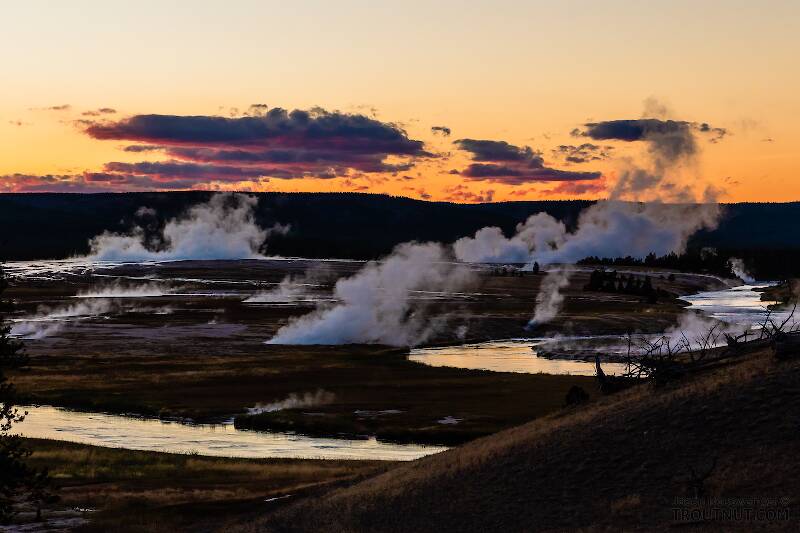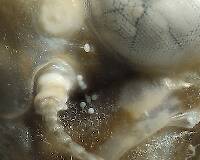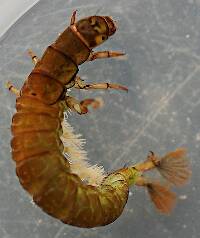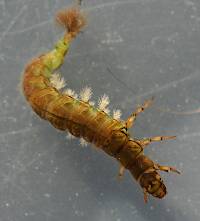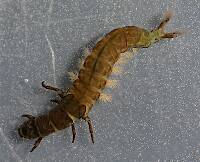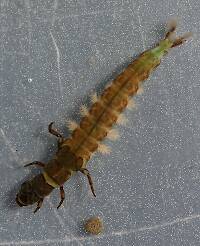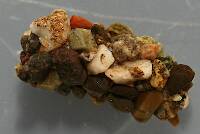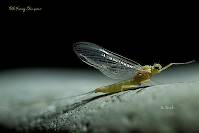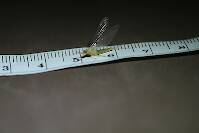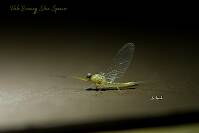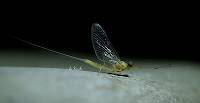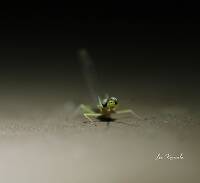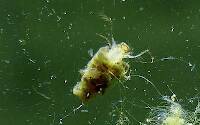
Blue-winged Olives
Baetis
Tiny Baetis mayflies are perhaps the most commonly encountered and imitated by anglers on all American trout streams due to their great abundance, widespread distribution, and trout-friendly emergence habits.
Featured on the forum

This one was surprisingly straightforward to identify. The lack of a sclerite at the base of the lateral hump narrows the field quite a bit, and the other options followed fairly obvious characteristics to Clostoeca, which only has one species, Clostoeca disjuncta.

Troutnut is a project started in 2003 by salmonid ecologist Jason "Troutnut" Neuswanger to help anglers and
fly tyers unabashedly embrace the entomological side of the sport. Learn more about Troutnut or
support the project for an enhanced experience here.
Creno on Dec 12, 2013December 12th, 2013, 10:46 am EST
No wonder there are so many. They don't wait around.
https://www.youtube.com/watch?feature=player_embedded&list=UUWIKyvubtVUwRLZkOda89rw&v=gtXX9J7iZQA
https://www.youtube.com/watch?feature=player_embedded&list=UUWIKyvubtVUwRLZkOda89rw&v=gtXX9J7iZQA
Taxon on Dec 12, 2013December 12th, 2013, 2:47 pm EST
Hi Dave-
That is an absolutely fascinating video. Thanks for sharing.
Incidentally, Cloeon cognatum, which has been reclassified as Cloeon dipterum, is not the only ovoviviparous N. American mayfly species, as the (11) N. American species of Callibaetis also share the trait of gravid females holding their eggs internally until embryonic development is complete.
That is an absolutely fascinating video. Thanks for sharing.
Most mayflies lay their eggs immediately after mating; the eggs then take anywhere from 10 days to many months to hatch. Cloeon cognatum is an exception. This species is ovoviviparous, which means that a mated female holds her eggs internally until embryonic development is complete (about 18 days), after which she lays them in water and they hatch immediately. This female was dropped onto the water surface moments before the video started. Video credit: David H. Funk
Incidentally, Cloeon cognatum, which has been reclassified as Cloeon dipterum, is not the only ovoviviparous N. American mayfly species, as the (11) N. American species of Callibaetis also share the trait of gravid females holding their eggs internally until embryonic development is complete.
Martinlf on Dec 12, 2013December 12th, 2013, 2:57 pm EST
Wow!
"He spread them a yard and a half. 'And every one that got away is this big.'"
--Fred Chappell
--Fred Chappell
Crepuscular on Dec 12, 2013December 12th, 2013, 4:14 pm EST
Thanks Dave! Very cool stuff. Hope you are doing well.
PaulRoberts on Dec 12, 2013December 12th, 2013, 7:20 pm EST
Very cool. Technology is just amazing. We get to see such wondrous things.
The hatch rate was very high with those. Looked like the little ones are programmed to disperse, and presumably end up in cover along shorelines.
Thanks for that, Dave!
The hatch rate was very high with those. Looked like the little ones are programmed to disperse, and presumably end up in cover along shorelines.
Thanks for that, Dave!
Taxon on Dec 12, 2013December 12th, 2013, 9:00 pm EST
Mack-
I believe the only ovoviviparous N. American mayfly genera to be Callibaetis and Cloeon. Please see my post above. :-)
Does anybody reading along know if the time frame here is relative to all mayflies ???
I believe the only ovoviviparous N. American mayfly genera to be Callibaetis and Cloeon. Please see my post above. :-)
Taxon on Dec 12, 2013December 12th, 2013, 9:17 pm EST
Hi Mack-
I share your excitement. It's one thing to read about, but quite another to actually see it happening in a video. As Louis said, Wow!
I share your excitement. It's one thing to read about, but quite another to actually see it happening in a video. As Louis said, Wow!
Crepuscular on Dec 13, 2013December 13th, 2013, 2:49 am EST
This video led me to another from stroud research on DR. Ruth Patrick.
Stroud is a cool place. Having spent some time there for trainings, and as a guest, I would encourage anyone who can to pay them a visit. I'm lucky it's only about an hour and a half from me. I also have some colleagues who worked there. Everyone that I have worked with has been super knowledgeable and talented individuals. Dr. David Funk is an excellent photographer and has done some really cool mayfly work. http://www.stroudcenter.org/about/funk.shtm
Lastchance on Dec 14, 2013December 14th, 2013, 5:17 am EST
Awesome video. That's the first time I've ever seen anything like it. From what I've read this is a member of the baetis family? Was this found in the US? I read that it is a UK bug. Please enlighten me.
Taxon on Dec 14, 2013December 14th, 2013, 8:32 am EST
Hi Bruce,
It is a member of family Baetidae.
Don't know, but have emailed Dr. Funk in order to ask, and will share his response.
From what I've read this is a member of the baetis family?
It is a member of family Baetidae.
Was this found in the US? I read that it is a UK bug. Please enlighten me.
Don't know, but have emailed Dr. Funk in order to ask, and will share his response.
Taxon on Dec 15, 2013December 15th, 2013, 6:32 am EST
This is the response received from Dr. David H. Funk in answer to the following question:
Was the video filmed in N. America, where my understanding is that Cloeon cognatum has been reclassified as Cloeon dipterum?
Was the video filmed in N. America, where my understanding is that Cloeon cognatum has been reclassified as Cloeon dipterum?
Video was shot in Pennsylvania. And yes, most people now consider cognatum a synonym of dipterum, but no one has officially sunk it and our North American populations fit the old world cognatum concept. Cloeon dipterum in the broader sense is native to Eurasia and is undoubtedly a complex of species. It is not native to North America, but probably came over on ships in the mid 20th century. I have "barcoded" our local population (using the mitochondrial COI gene) and it matches exactly a specimen collected in Bulgaria. This species is now very common in northeast North America, especially in fishless ponds.
Best regards,
Dave
PaulRoberts on Dec 15, 2013December 15th, 2013, 8:26 pm EST
Wow, again. Great thread.
Entoman on Dec 18, 2013December 18th, 2013, 12:19 am EST
An invasive species of mayfly? New one on me! Thanks, Roger.
"It's not that I find fishing so important, it's just that I find all other endeavors of Man equally unimportant... And not nearly as much fun!" Robert Traver, Anatomy of a Fisherman
TNEAL on Dec 22, 2013December 22nd, 2013, 7:34 am EST
maybe they'll eat the invasive species of Asian carp about to decimate great lakes fishery.......
Quick Reply
Related Discussions
Topic
Replies
Last Reply
17
Nov 22, 2014
by Millcreek
by Millcreek
5
Sep 10, 2020
by Leskorcala
by Leskorcala
2
Feb 2, 2018
by PaulRoberts
by PaulRoberts

